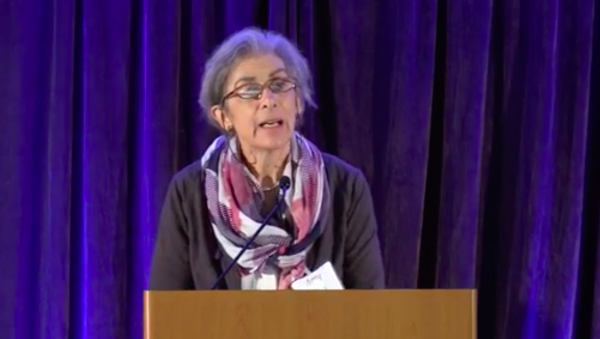
Last week, a group of conservative intellectuals and media figures met in a Ritz-Carlton in Washington, DC, to discuss “national conservatism”: a new vision for the right that the conference organizers describe as “inextricably tied to the idea of the nation, to the principle of national independence, and to the revival of the unique national traditions that alone have the power to bind a people together.”
One panel on immigration — a major topic throughout the conference — stood out in particular. University of Pennsylvania law professor Amy Wax, no stranger to culture-war controversies, used her talk to argue for an immigration policy that would favor immigrants from Western countries over non-Western ones — “in effect,” she said, “taking the position that our country will be better off with more whites and fewer nonwhites.” She believes this is not racist because her view is “grounded firmly in cultural concerns — doesn’t rely on race at all.”
When I first reported these comments, it kicked off a controversy and landed Wax in trouble. By Friday afternoon, more than 1,000 people — many of whom were Penn students and alumni — had signed a petition for Wax to be removed from her teaching responsibilities.
Yoram Hazony, an Israeli conservative intellectual and one of the conference’s conveners, subsequently accused me of misrepresenting Wax’s position in a Friday Twitter thread (after sharing my piece two days earlier):
Hazony’s accusation was false; I reported Wax’s comments at the conference accurately. I was in the room when she said it, I listened to a recording afterward to make sure I got it right, and journalists from the New York Times, BuzzFeed, and the New Yorker who were there have all confirmed what I reported.
But more important — and revealing — than his allegation of inaccuracy was his take on Wax’s argument. Stressing that he didn’t have a “position on Wax’s position,” he assailed the cries of racism aimed at Wax since she did not propose racial quotas explicitly and rooted her views in culture rather than biology.
Let me stress this point: Hazony’s view is that it is not racist at all to argue that the country, in Wax’s words, “will be better off with more whites and fewer nonwhites,” so long as you argue on cultural rather than biological grounds.
That Hazony and company can stare at Wax’s phrase and not discern racism speaks volumes.
What Amy Wax believes about immigration
Wax’s address was based on a 2018 Georgetown Journal of Law and Public Policy paper titled “Debating Immigration Restriction: The Case for Low and Slow.” In the paper, Wax argues that America’s debate over immigration has been warped in a pro-immigration direction by “left-leaning elites,” whose “reactive, highly emotional, and one-sided” approach to the issue has made a serious debate over policy possible. It is the right and only the right, she argues, that is willing to talk unsentimentally about the harms from mass immigration.
Wax’s paper splits the case for lower immigration rates into two buckets: the economic and the cultural. Her economic arguments follow those of Harvard economist George Borjas — that low-skill immigration lowers wages for native-born Americans and is a drain on the welfare state — as well as one of her own articles, written with policy analyst Jason Richwine (who has also run into controversy), arguing that such immigrants take jobs from native-born Americans. These claims are certainly debatable — Borjas is somewhat of an outlier in his field — but relatively straightforward.
Culture is, in Wax’s phrase, a bit more “elusive.” She defines the core of the cultural case for immigration restriction as this:
There are two ways to make this case, per Wax. One set of people, “creedal nationalists,” believe that immigrants from all backgrounds can move here without disrupting American society. But such assimilation takes time, so it might be wise to keep the pace of immigration slow and the number of immigrants low. “For this ilk of nationalist, there is no obstacle to America’s core ideas being successfully adopted and embraced, and equally so, by people regardless of ethnicity and national origin,” she writes.
A different group, “cultural distance” nationalists, “draw a sharp distinction among potential newcomers based on culture of origin and national background.” In essence, they hold that immigrants from some backgrounds are not assimilable — specifically, immigrants from non-Western nations are extremely unlikely to be able to accept the norms and values that would make them contribute to American society.
“Many cultural-distance restrictionists endorse the notion of maintaining a majority ‘legacy’ (European and Anglo-Protestant) population,” she writes. “Immigration from non-Western countries should thus be kept at a minimum so as not to compromise the dominance of groups that are closer to our cultural heritage and more effective at transmitting it.”
Who are the people advocating this view? Wax cites John Derbyshire, a right-wing writer who formerly wrote for the mainstream National Review. Derbyshire was fired from this job for penning a piece in which he advises his children that “if you are at some public event at which the number of blacks suddenly swells, leave as quickly as possible.” Other places that Wax credits for “thoughtful discussion” of these issues are Taki’s Mag, the alt-right publication where Derbyshire published his screed about “the number of blacks,” and VDARE, another leading alt-right publication. (The pro-Trump Journal of American Greatness and the marginal right-wing site Jacobite were also mentioned.)
This idea — cultural distance nationalism — is what seems to especially interest Wax in her paper. It’s an idea whose implications are extremely troubling if you believe in a multicultural, pluralistic America. Cultural distance nationalism makes blanket judgments about people based on their national origin and ethnic identity. It also argues that immigration policy must not be allowed to “compromise the dominance” of “European and Anglo-Protestant” people in the United States and Europe.
To be clear, Wax does not clearly side with the “cultural distance” view in her paper. She does, however, lament that “thoughtful discussion of these positions is effectively banished from public fora and relegated to obscure corners of the internet,” and her argument that there is “stark evidence that individual and group attitudes do differ dramatically around the globe” suggests some sympathy for its conclusions.
Her talk last week was modeled on her paper but also was more straightforward about her position.
“My focus will be on what I term the cultural case for restriction,” Wax told the conference. “My position here [italics added] is that conservatives need a realistic approach to immigration that best serves and preserves our country’s status and identity as a relatively high-functioning, at least for now, Western and First World nation.”
She dismisses the creedal nationalist position that non-Western immigrants can be taught to accept supposedly “Western” values like capitalism and the rule of law:
If creedal nationalism is flawed, what’s the alternative? It is “the second type of nationalism … I want to concentrate on: I term it cultural distance nationalism,” she says. “According to this view, we are better off if our country is dominated numerically, demographically, politically — at least in fact, if not formally — by people from the First World, from the West, than by people from countries that have failed to advance.”
Wax believes that “Third World” countries are chronically poor and that this poverty is the result of the poor cultural habits of the people who reside in it. If they are allowed into the United States, the country will start to develop the dysfunction she sees in “Third World” economies.
“[NYU professor] Larry Mead, in his new book The Burdens of Freedom, has argued that individualism —a key source of Western and American order, dynamism and strength — is a distinctly First World attribute that is difficult to impart to outsiders and that it is key to maintaining our freedoms and prosperity,” Wax says. “These insights are supported by the European experience with Muslim immigration … and by the multigenerational trajectory of Hispanics in the United States.”
To further support this point, she cites a popular alt-right phrase — “the dogma of magic dirt,” a dismissal of the notion that non-Western migrants with deeply distinct cultural values can be assimilated. Here’s Wax using the phrase, popularized by people including Derbyshire (and note how she refers to the alt-right, euphemistically, as the “dissident right”):
If this were the entirety of what she said, it would be enough — dayenu, as we Jews say — to establish that her position on immigration is bigoted. As if we needed more evidence, she even favorably cites one of Trump’s most offensive outbursts as a positive example.
“These are toxic topics that lie outside the Overton window in polite society — as evidenced by outraged reaction to Trump’s profane and grating ‘why are we having all these people from shithole countries come here?’ That needs to be regarded as a serious question and not just a rhetorical one. [audience applause]”
But then we get to the part where she explicitly addresses the issue of race. I want to quote her entire discussion of the issue, though it’s long, to make sure you have the proper context:
So the argument is this: Wax believes it would be better for the country if the proportion of white citizens were higher than the proportion of nonwhite citizens. And she believes we need an immigration system that keeps immigrants from non-Western countries to a minimum.
This is not racist, in Wax’s view, because the system only discriminates against nonwhites “in effect” — it is based on national origin rather than race, and her problem with nonwhite immigrants is cultural rather than biological. Thus can someone who says “our country will be better off with more whites and fewer nonwhites” say this isn’t racism with a straight face.
Let’s recap: Wax believes that nonwhite immigrants are flawed by virtue of who they are, and nothing can be done to change their character and allow them to assimilate. She admits that she is making blanket judgments about nonwhite populations and is using those judgments to endorse policies that would disadvantage them and ensure that America’s white population outnumbers its nonwhite one. She comes to these conclusions, in part, based on a political doctrine — cultural distance nationalism — that she herself identifies with the alt-right.
During the Q&A after the speech, Wax was asked what would happen if conservatives lose the immigration fight (thus leaving rates relatively high). Her prediction is dire:
If all this isn’t racism, I have no idea what is.
Where does “national conservatism” go from here?
Yoram Hazony and his “national conservatism” event co-organizers went to significant lengths to denounce nakedly racist ideas. In one plenary address, for example, Hazony referred to alt-right racism as a form of “insanity.”
So how could this popular thinker on the mainstream right who claims to abhor racism possibly defend Wax’s address? It’s worth taking a look at his whole Twitter thread on the subject. I won’t reproduce all of it — though I encourage you read every word at the link — but here, again, is the first and most relevant part of it:
There are, roughly speaking, three arguments in the complete thread that Hazony kind of muddles together: that Wax didn’t say what she apparently did; that Wax’s view as described is not racist; and that Wax’s perspective was an important one to spotlight at his conference on “National Conservatism.” I will take them in turn and attempt to explain what’s at stake.
First, Hazony argues, “Wax did not propose racial tests for immigration, and did not say that her own position is that America ‘will be better off with more whites and fewer nonwhites.” Rather, he claims that I “pulled these words out of context, and apparently misunderstood Wax’s argument.”
This is flatly false. Any fair reading of her remarks shows that Wax is describing her own preferences in that passage. She clearly believes that the country would be improved if the immigration system admitted more whites and fewer nonwhites — not because nonwhites are biologically inferior, but because they are culturally inferior. This is just the plain meaning of the words in context.
His second, and much more interesting, argument is that Wax’s views are not actually racist.
“Wax advocated an immigration policy that favors immigrants with cultural affinities to the U.S. She emphasized that the position she was defending ‘doesn’t rely on race at all,’ ” Hazony writes.
This is a remarkable position. Hazony’s view seems to be that if you make negative generalizations about the vast bulk of the world’s nonwhite population, and put forward policies that hurt them, it’s not racist so long as you say the problem is “culture” rather than “biology.”
A hypothetical might help clarify the problem with this argument. Let’s say an accounting firm in Los Angeles had a policy of not hiring people born in Mexico or other Latin American countries because it believes a stereotype that they are “lazy” (by culture, not by nature, of course). Imagine that the firm’s CEO said that “our company will be better off with more whites and fewer nonwhites.” And then, after a reporter publishes this comment and the inevitable lawsuit begins, the company’s defense is this: “We didn’t discriminate against Mexicans because we think they’re biologically inferior to whites, but because Mexican culture is characterized by a poor work ethic.”
That’s an absurd defense, obviously. It doesn’t matter that the company is using national origin instead of race to discriminate, or that the reasoning behind the discrimination is “cultural” rather than “biological”: It is still using negative stereotypes to discriminate against people from a particular ethnic background.
On Wax’s reasoning, this wouldn’t be racist. And this is reasoning that Hazony seems to endorse in his Twitter thread. His view is that arguments cannot be racist if they do not explicitly ground themselves in a biological theory of race, even if they result in racial discrimination in effect.
Now let’s tackle the third and final argument: that Wax’s perspective is worth hearing, he argues, and that any new political movement needs to carve out space for open and frank discussion while finding its identity.
“I don’t personally have a position on Wax’s proposals. But the views she presented at the National Conservatism Conference are legitimate and should be heard and debated,” he writes. “Nor do Wax’s comments prove that the National Conservatism Conference is crypto-racist as others have been quick to infer. It just proves that we were doing our job: Inviting out-of-the-box thinkers who are willing to take risks and say new things.”
I’m all for free and open discussion. But when hosting an ideological conference like this one, you have to make choices about what kinds of views you want represented and which ones don’t cohere with the ideas you’re trying to develop.
This isn’t an issue of censorship — if it were, liberals would have been “censored” by not being invited to host their own panels at the conference. Rather, it’s an issue of defining the nature of your ideological movement: the kinds of ideas that you choose to spotlight and believe contribute to the ideology you want to create.
In the case of “national conservatism,” one of the biggest concerns is that their movement becomes identified with racism or, worse, a fig leaf justification for it. Hazony and his fellow organizers carefully pruned the guest list for precisely these reasons — specifically denying several leading alt-right figures’ applications to attend.
One person on the rejected list was Peter Brimelow, the founder of VDARE. Hazony and another conference organizer, David Brog, sent Brimelow a letter saying that he has “publications and professional associations that are incompatible with national conservatism as we understand it.” Hazony and Brimelow then had a whole fight about it on Twitter.
If that’s the standard, Wax wouldn’t pass it. In her Georgetown paper — the basis for her talk — she explicitly singles out Brimelow’s VDARE as a place for “thoughtful discussion” of “cultural distance” nationalism.
But this didn’t raise a red flag. Nor did Wax referring to John Derbyshire, who helped spread the “magic dirt” phrase, as “my friend” in a 2018 speech on immigration to the far-right Social Contract press. Nor did Wax giving an address to the H.L. Mencken Club, an alt-right organization so toxic that a Trump speechwriter was fired after the White House learned he had appeared on one of its panels (one of his fellow panelists was Peter Brimelow). And that’s to say nothing of her main reason for mainstream notoriety in the first place, her claim that “I don’t think I’ve ever seen a black student graduate in the top quarter of [Penn Law’s] class.”
None of this seemed to have bothered Hazony and the other conference organizers. Not only was Wax invited to attend the conference, she was actually given the opportunity to speak on a panel.
It is not impressive that the national conservatism conference managed kept out the most visible members of the alt-right. The real test of the movement’s professed opposition to racism was what would happen when ideas touted by VDARE and the alt-right were repackaged by an Ivy League law professor.
It is a test that Hazony and his conference flunked.
Sourse: vox.com






